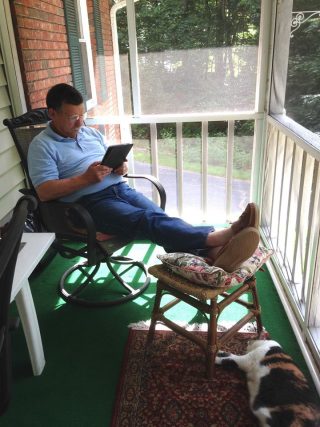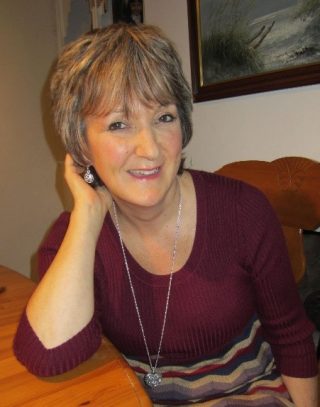I am not a cover designer but I can agree that cover layouts play an important role in the overall presentation of books and I must admit, often times I first judge a book by its cover. ********** Synopsis B.R.A.G. Medallion Honoree How do you find the strength to embrace a future that’s different than the one you planned? For Sarah Mitchell, the answer is simple–you don’t. For two years, Sarah has shut herself off from most of the world around her. She needs to move on, but doesn’t know how to begin. Unexpectedly, Sarah is presented with an opportunity that could change everything. Elijah Kingston, her firm’s largest client, wants her to lead a highly confidential assignment. When Sarah learns the shocking nature of Kingston’s project, she is torn between Elijah’s promise of healing and her fear of falling deeper into despair. Kingston’s Project is a poignant story about the effects of grief and the loss of hope. Can Sarah find happiness again, or is the hold from her fear and guilt too strong to break free? *********** This cover stands out to me in such a reflective way. You have a girl or woman-if you will-standing by a…
Our community of self-published authors is generous with the knowledge they have gained on their writing journey. Here at Writers, Readers & Self Publishing, we will share with you their advice, their experiences and their ideas for writing and promoting award-winning books. We will also share incites from our readers and others in the field of self-publishing such as editors, designers and successful best-selling authors who graciously share their thoughts and experiences. Our readers and writers have also contributed some fun and interesting stories that we hope you will enjoy!
Book Promotion Goals and the Strategy Behind Meeting Them
The book writing business can be challenging considering the effort required to produce a good product, significant upfront investment, and a highly-competitive market. And with the invasion of so many self-published authors over the past few years, it’s getting harder and harder to get noticed. In this article, I share my goals as an author and the strategy I used to achieve them. I have been writing novels for seven years and have published five books, the first one released in 2012. My promotion goals, which are tied to my financial goals, have changed over time due to a heightened knowledge of the industry, the number of books under my belt, discovery of new promotional tools, and an ever-changing publishing industry. The financial goal I set for my first book was to break even—not a very lofty goal, but a reasonable one for a first-time author—and I wanted to do it within six months. Having invested $3,200 in its production (editing, formatting, cover design, press release, etc.), that meant selling either 840 paperback copies, 2,100 Kindle copies, or some combination of the two to break even. Determined not to fall into that large group of new authors who sell less…
Crime Fiction with Award Winning Author Douglas Carlyle
We’d like to welcome two time award winning author Douglas Carlyle to take part in our crime fiction week. Doug, when writing crime fiction, there is usually several characters involved. What is your advice in presenting each character so they stand out? There will be a protagonist and an antagonist in any crime fiction novel. Both must have a strong presence. The author must directly and indirectly describe the physical and intellectual attributes of the good and evil characters, but only with enough detail so as to allow the reader to embellish with his or her own pallet of colors. As the author, I find opening the window to the inside of our hero (heroine) and villain equally exciting. However, for me, one distinguishing feature is that as for the protagonist, humor sets that character apart from the antagonist. I’m not speaking of being a deadpan jokester. Rather, he/she may have a dry wit, colorful language, peculiar quirks. Humor attracts the reader to the good side and allows them to fall in love with that character. I think it is important for writers to give conflicting reasons for their characters to be criminals. For readers to find that connection-if you…
Crime Fiction With Award Winning Author Joe Perrone, Jr.
Today Stephanie interviews B.R.A.G. Medallion Honoree Joe Perrone about his crime fiction work. Joe, when writing crime fiction, there are usually several characters involved. What is your advice in presenting each character so they stand out? In creating the main character for the first book in the Matt Davis Mystery Series, As the Twig is Bent, I already had an actual person in mind for the character of Matt Davis. I had seen a television commercial with a man who I thought Matt should look like, and I literally drew my character to physically resemble that actor. I think it helps to have a specific person in mind, or at least have an idea of what your character ought to look like. More than that, however, it is important to “flesh out” your character with: physical appearance; clothing preferences; likes and dislikes; quirks; level of education; life experience, etc. I actually make a list of my main characters in a separate document, with their physical and intellectual attributes that I may consult many times in the course of writing a book. Minor characters who are seen only momentarily can be made up on the spot and described as “the mailman,…
Writing Crime and Mystery Novels!
The indieBRAG Crime and Mystery Series I am pleased to introduce RAR Clouston author of The Covenant Within Bob, welcome and thank you for sharing with us- Stephanie: When writing crime fiction, there are usually several characters involved. What is your advice in presenting each character so they stand out? Bob: At the risk of sounding like my social psych professor in what seems like an eternity ago during my undergraduate days as a psychology major, we are all the product of both nature and nurture. And this is never truer than with the villains who populate thrillers and mystery stories. We are shaped by the multitude of forces, both genetic and social, that make us who we are. What drives someone to a life of crime, or even worse, to become a heartless killer? An obvious answer is that they were the offspring of truly evil parents who gave them tainted genes, or raised them in a cruel and heartless home, or both. But there are also exceptions to this as evidenced by the cases of cold blooded killers who came from a “normal’ home. My point is this: we are all different and as such a writer…
Crime Fiction With Award Winning Author Kathryn Guare
Crime Fiction is a popular worldwide and indieBRAG has many great award winning authors who write in this fascinating genre. Today Stephanie talks with B.R.A.G. Medallion Honoree Kathryn Guare who wrote Deceptive Cadence. A story we highly recommend. Stephanie: When writing crime fiction, there is usually several characters involved. What is your advice in presenting each character so they stand out? Kathryn: Most of the effort goes into developing the main protagonists, of course, but I think the minor characters are important as well. They offer an opportunity to add layers of color, and the main characters are made richer if they are interacting with something other than cardboard cutouts. When you’ve got a lot of characters, it’s easy to be lazy and pull stock figures from central casting (hairy-chested Russian arms dealer with lots of neck jewelry), but if I spend a little more time on it, I can always come up with a unique and more complicated three-dimensional person that I find more interesting (what if the Russian arms dealer is also a committed yoga practitioner? How would that change his physical appearance, mannerisms and personality?) Stephanie: I think it is important for writers to give conflicting reasons…
Crime Fiction With Award Winning Author Debrah Martin
Stephanie has asked psychological and crime fiction writer Debrah Martin (also writing as D.B. Martin) how she tackles writing a thriller. Here are some of her suggestions. Q: When writing crime fiction, there are usually several characters involved. What is your advice in presenting each character so they stand out? A: Crime writing is really no different to any other kind of fiction writing. The characters have to be credible and likeable – or so wholly unlikeable/intriguing that they still fire the reader up enough to want to find out what happens to them. Spend some time deciding on your individual character’s strengths and weaknesses, their challenges or their nemesis. We all have an Achilles heel. What is theirs? What is it that forces your protagonist to take up the fight – or commit the crime? And how will they ultimately redeem themselves, or ‘face the music’. I usually pick from something like this to set up the main personality traits for each of my characters: Then I pair, group and counterpoint them between characters. Physical attributes can sometimes complement or highlight personality traits too. Then I think about where they will fit in the plot, and how…
Interview with Crime Fiction Writer and Award Winning Author Liv Hadden
We’d like to welcome B.R.A.G. Medallion Honoree Liv Hadden today. Stephanie has some interesting questions to ask her about crime fiction. Liv, when writing crime fiction, there is usually several characters involved. What is your advice in presenting each character so they stand out? For me, dialogue is a great way to create distinctions between characters. For example, my main character is extremely sardonic, and that comes across in their responses to others via word choice and sarcasm. One of my supporting characters is young, naïve, and extremely positive, so his dialogue reflects that with a lot of “dudes, bros” and exclamations. I also think physical attributes, like a nervous tick, are great ways to define characters. I think it is important for writers to give conflicting reasons for their characters to be criminals. For readers to find that connection-if you will-or to perhaps sympathize with them. How do you pull that off and what is your advice on doing so? Honestly, I think this is easy. Think about real life—all humans are complicated. We all have complex intentions and motivations as well as rich histories. Society does a disservice to humanity by labeling someone as “bad” or “good”. What…
Staying Single in Regency England with Maria Grace
Regency society organized itself around marriage and family. Adults were identified by their place, or lack thereof, in a married, family unit. Married women were ranked higher and more respected than the unmarried. Married men were perceived as having come into their own and given the esteem and authority that went with such an accomplishment. The plight of the regency spinster is fairly well understood. The local tax or judicial records says it all. Women were typically identified in tax or judicial records by their marital status (spinsters, wives and widows) whereas men were always identified by their occupation or social status. (Shoemaker, 1998) A woman’s identity (and legal existence) was determined by her marital status. Spinsterhood was considered ‘unnatural’ for a woman, even though nearly one in four upper class girls remained unmarried (Day, 2006). They were called ‘ape-leaders’ (for that was what they would be doing in hell as punishment for the unnatural lifestyle. Enough said on that point….) and ridiculed for their failure in the most basic requirements of femininity. However, if a single woman possessed independent means—a fortune of her own sufficient for her to live on, it was possible she could maintain her own household…
An Eighteenth Century Love Letter by Lucinda Brant
The eighteenth century saw an explosion of letter writing on a scale never seen in previous centuries, and similar to what we are experiencing today with the flood of digital communication. Everyone wished to express an opinion on all manner of topics, from the current political climate, to the war in the American Colonies, crime rates, and what the fashionable were wearing in town. Letters were the main form of communication and none mattered more than those professing love. Receiving a physical love letter was something to cherish, as it is today, to be carefully read and re-read and kept as a treasured object. In my Roxton Family Saga, the Duke of Roxton leaves his bride a love letter on her dressing table, the morning after their wedding night. Roxton is a nobleman who chooses his words carefully, and thus is economical in his conversations, both spoken and written. His title, pre-eminent position in society, and arrogance mean one word or a look from him is sufficient to convey his wants and needs, most of which are often anticipated. Thus his love letter is all the more significant, and serves a dual purpose—of reassuring his bride of his deep love…
Most Shared Posts
- On the road with Apple Turnovers!
- Grab a Meat Pie and travel back in time!
- A closer Look
- Egyptian Jews- a Culinary Community
- What do you know about self-publishing?
- The Plague!
- Trucking Together!
- A conundrum!
- Memories of the Deli-
- Time Travel
- A Trip into Medieval England
- Ahh! Summer Reading & a Lovely Tomato Salad
- Time Travel
- A Memorial Day Special!
- Delicious Savory Onion Pie is paired with this month’s Foodie Lit historical novel, Infants in the Brush.
- “I TRIPLE-dog-dare ya!”
- Handfasting- a commitment by joining hands
- Attention Mainstream & Self-Published Authors!
- Have you ever wondered how snowflakes are made?
Most Discussed Posts
- On the road with Apple Turnovers!
- Grab a Meat Pie and travel back in time!
- A closer Look
- Egyptian Jews- a Culinary Community
- What do you know about self-publishing?
- The Plague!
- Trucking Together!
- A conundrum!
- Memories of the Deli-
- Time Travel
- A Trip into Medieval England
- Ahh! Summer Reading & a Lovely Tomato Salad
- Time Travel
- A Memorial Day Special!
- Delicious Savory Onion Pie is paired with this month’s Foodie Lit historical novel, Infants in the Brush.
- “I TRIPLE-dog-dare ya!”
- Handfasting- a commitment by joining hands
- Attention Mainstream & Self-Published Authors!
- Have you ever wondered how snowflakes are made?
Blog Categories
- Anne R. Allen
- Authors' Chat
- award winning books
- Bloggers
- Book Giveaway
- Book Marketing
- Book Spotlight
- Christmas
- Crime and Mystery
- Editing
- Editing by Ellie
- Food for Thought
- Foodie Lit
- From Fact to Fiction!
- genres
- Graphic Design
- Halloween
- In Praise of indieBRAG
- indieBRAG
- indieBRAG 2017 Cover Contest
- indieBRAG Kids
- indieBRAG News!
- Legal Tips from Helen Sedwick
- Marketing an indie Book
- Middle Grade Reader
- Novel Conversations with Helen Hollick
- Readers Thoughts!
- Romance
- Steena Holmes
- teen books
- Teen Week
- Thanksgiving
- The B.R.A.G.Medallion
- The Self-publishing World
- The World of Reading
- Words of Wisdom
- Writers, Readers & Self Publishing
- young adult









